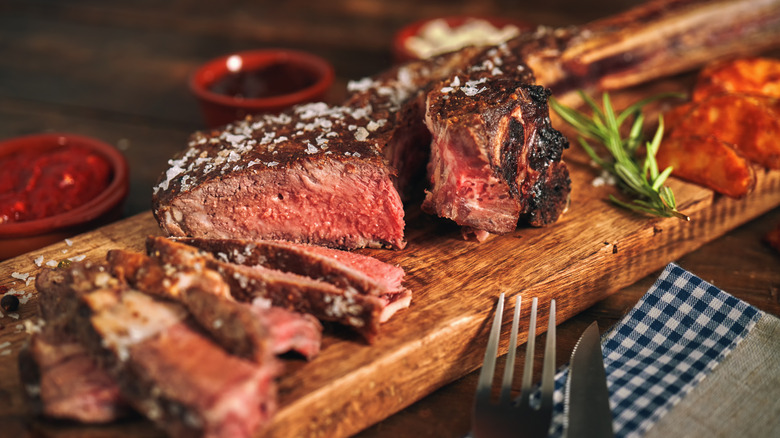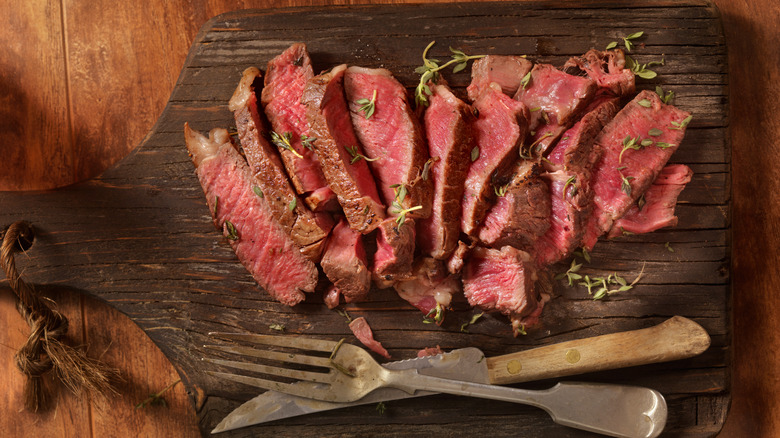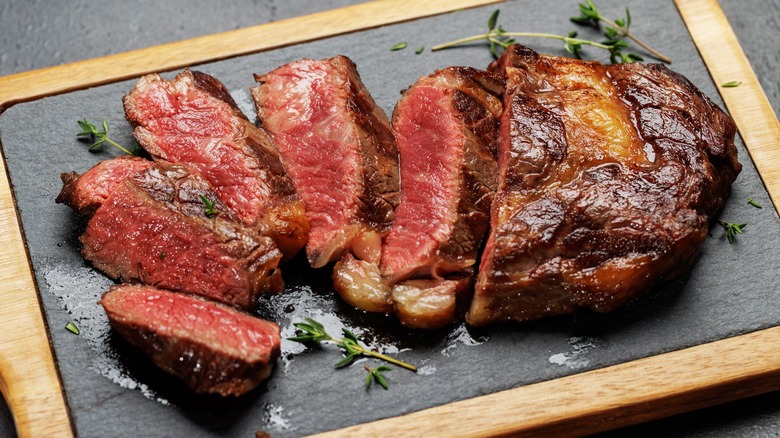Prime Rib Vs Ribeye: The Flavorful Difference Between Luxury Beef Cuts
Ordering steak is a tricky business. There are almost infinite cuts to choose from, with almost as many preparations. So, it's no wonder that many diners find themselves confused regarding the differences between various steaks. This is particularly true of two very premium steak cuts: prime rib and ribeye. Both cuts of steak are highly prized among beef aficionados for their tender texture, juicy meat, and rich flavor. But there is a key difference between prime rib and ribeye that you'll want to keep in mind the next time you head to the butcher (or your local steakhouse).
Both prime rib and ribeye come from the same portion of the cow, called the primal rib. This section sits at the front of the cow, right beneath the backbone. Because this section of the cow isn't often exercised, the resulting meat is incredibly soft. Both prime rib and ribeyes are highly sought after cuts of steak and tend to be on the more expensive side. However, despite these similarities, these steaks are actually quite different. Essentially, the ribeye steak is a prime rib steak sliced into smaller pieces, whereas prime rib is less processed. And though this difference may seem small, it actually has a big impact on how the steaks are prepared and served.
What 's so special about prime rib
Perhaps the most important difference between prime rib and ribeye steaks is in their preparation. Unlike ribeye steaks cooked after being cut from the larger rib primal, prime rib steaks are removed from the larger cut after cooking. Additionally, these larger cuts of meat aren't cooked as you would a steak, with high heat at short intervals, but as a part of a larger roast — meaning they're cooked at a lower temperature over longer periods. However, this doesn't mean your prime ribeye should be cooked like a brisket, braised or barbecued. Rather, prime rib is best served with a pink center, which will be most tender. Overcooking your prime rib, on the other hand, will cause it to be tough, thus removing the cut's main appeal.
You will also want to fully rest your prime rib before carving, as this will ensure it maintains its juiciness and flavor. If you're ordering prime rib from a restaurant, it is important to keep in mind that it is prepared ahead of time due to its slow-cooking nature. For that reason, there is often less variability in cook customization. So, if you want to order your prime rib very rare or well done, you might want to try another cut.
Getting the most of your ribeye
Ribeye, on the other hand, is ripe for customization. Unlike prime rib, ribeye steaks are cooked individually after being cut from their larger primal. Ribeyes are best when cooked for shorter times at higher temperatures. Methods such as pan searing, reverse searing, and grilling are perfect for the delicious and tender ribeye. Additionally, when ordering ribeye at a restaurant, you can order your cut to your preferred doneness, as each steak is made to order. Rare or medium rare is preferred for ribeyes, as it allows for maximum tenderness. However, if you prefer a well-done steak, you should pick out a cut with heavy marbling, as the higher fat content will help keep the steak juicy and soft.
However, like prime rib, ribeye is a rich and delicious steak that is best served as part of a substantial meal. The cuts' butter-like flavors and beefy taste make them great for pairing with dishes such as scalloped potatoes, mashed potatoes, or a rich and creamy serving of macaroni and cheese. After all, these expensive cuts of steak deserve a pairing that can hold its own against their distinctive taste.


